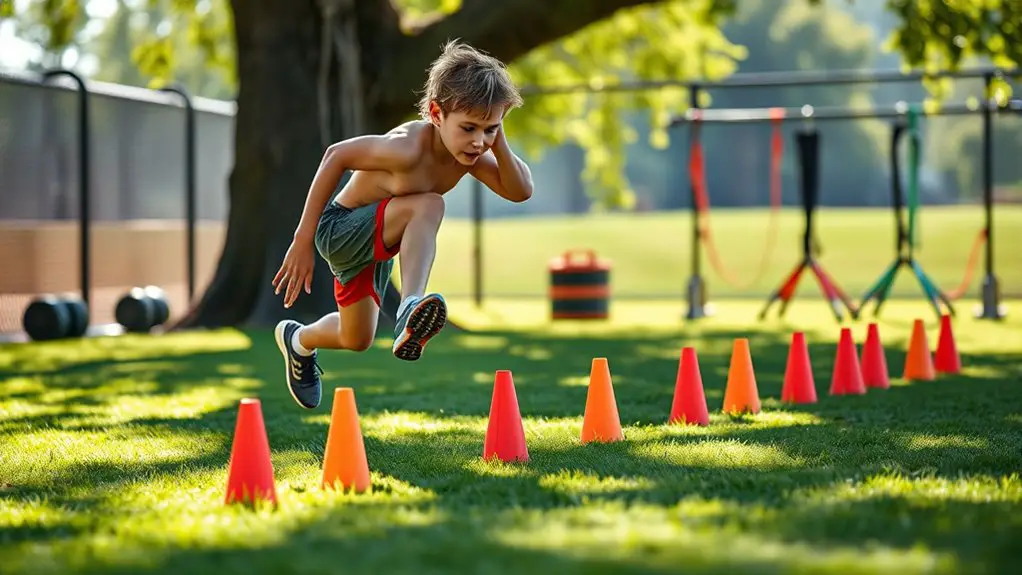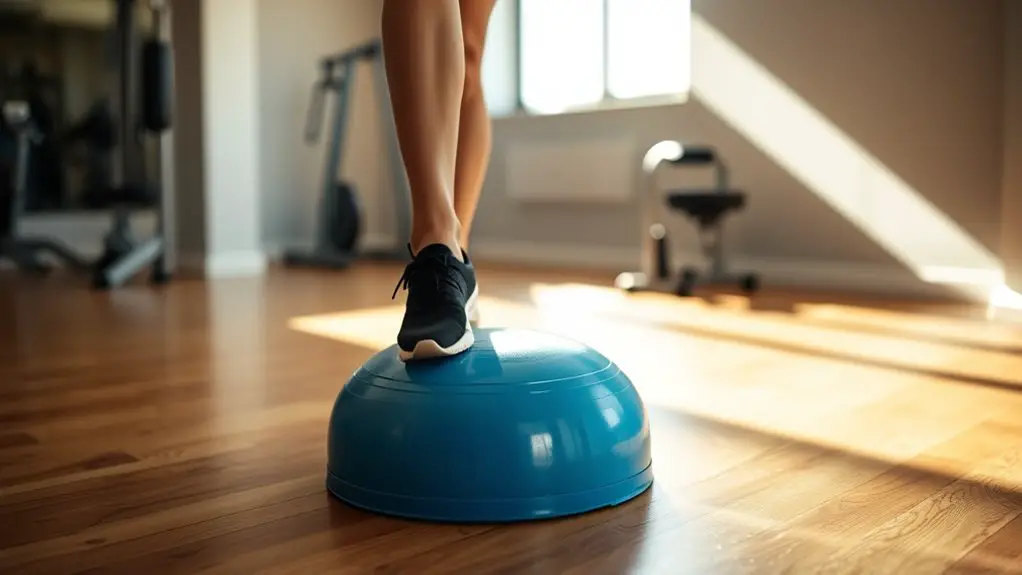Unilateral training is essential for athletes because it helps you address muscle imbalances, enhancing overall strength and stability. By working one side of your body at a time, you'll improve coordination and balance, which can lead to better performance in your sport. It also reduces the risk of injuries by strengthening weaker muscles and promoting joint stability. Getting into unilateral exercises can transform your training, and there's more to discover about the benefits they offer.
Understanding Unilateral Training
When you think about training, you might picture traditional exercises that engage both sides of your body equally. However, unilateral training flips that script, focusing on one side at a time. This method challenges your coordination, balance, and strength in ways you might not expect. By isolating each limb, you can uncover hidden weaknesses and improve muscle control. Plus, it allows you to break free from the monotony of standard workouts, adding variety and excitement to your routine. You'll also find that unilateral exercises can enhance your athletic performance by promoting functional strength and stability. Embracing this approach can lead to a more balanced, powerful physique, giving you the freedom to excel in your sport and beyond.
Benefits of Addressing Muscle Imbalances
Addressing muscle imbalances can greatly enhance your overall athletic performance and reduce the risk of injury. By focusing on unilateral training, you can reveal multiple benefits that will set you free to perform at your best. Here are some key advantages:
- Improved strength: Targeting weaker muscles helps balance your overall strength.
- Enhanced flexibility: Balancing muscle development can lead to better range of motion.
- Injury prevention: Strengthening underused muscles decreases the likelihood of strains or sprains.
- Better posture: Addressing imbalances supports a more aligned body, improving your stance during activities.
- Increased confidence: Knowing you're addressing weaknesses can boost your mental game.
Embracing these benefits will not only elevate your performance but also empower you to enjoy your athletic journey.
Enhancing Coordination and Balance
While many athletes focus on strength training, enhancing coordination and balance through unilateral exercises can greatly improve your overall performance. By incorporating single-leg squats or one-arm rows into your routine, you'll challenge your body to stabilize itself, honing your neuromuscular control. This isn't just about lifting heavier weights; it's about mastering your movements. When you train one side at a time, you'll discover hidden strengths and weaknesses, allowing you to fine-tune your body mechanics. Imagine the freedom of moving with precision and agility in your sport! As you develop better coordination and balance, you'll find yourself more in control, making split-second decisions with ease. Unilateral training is key to unlocking your potential on the field or court.
Injury Prevention Through Unilateral Exercises
Incorporating unilateral exercises into your training regimen can greatly reduce the risk of injury, especially for athletes who often favor one side of their body. By focusing on one limb at a time, you can address imbalances and enhance overall stability. Here are a few key benefits:
- Strengthens weaker sides: Targets imbalances that may lead to injuries.
- Improves joint stability: Encourages better control and support around joints.
- Enhances core engagement: Forces your core to work harder, improving overall strength.
- Increases flexibility: Promotes a greater range of motion in your muscles and joints.
- Reduces overuse: Lessens strain on dominant muscles, preventing fatigue-related injuries.
Embracing unilateral training not only keeps you strong but also helps you stay injury-free.
Improving Sport-Specific Performance
As you focus on improving sport-specific performance, unilateral training can play an essential role in enhancing your skills in various athletic disciplines. By isolating each side of your body, you can address imbalances that may hinder your performance. This targeted approach helps build strength, coordination, and stability, allowing you to execute movements more effectively during competitions.
When you engage in unilateral exercises, you're not just improving power; you're also enhancing your agility and speed, which are significant in many sports. Plus, this training method promotes better body awareness, enabling you to react swiftly in dynamic situations. Embracing unilateral training can elevate your game, giving you the edge you need to perform at your best while enjoying the freedom of movement.
Implementing Unilateral Training in Your Regimen
To effectively implement unilateral training in your regimen, it's crucial to start by evaluating your current strengths and weaknesses. This self-assessment allows you to tailor your training effectively. Here are some steps to help you get started:
- Identify imbalances in strength and stability between limbs.
- Choose a specific day for unilateral workouts, separate from your regular training.
- Focus on form and control, especially during the initial sessions.
- Gradually increase intensity and volume as you adapt.
- Keep track of your progress to guarantee balanced development.
Common Unilateral Exercises for Athletes
After evaluating your strengths and weaknesses, you can begin incorporating common unilateral exercises into your training routine. These movements can enhance your balance, coordination, and overall performance. Start with the single-leg deadlift, which targets your hamstrings and glutes while improving stability. The single-arm dumbbell press is another excellent choice, as it helps develop shoulder strength and core stability. Don't forget about the Bulgarian split squat; it's fantastic for leg strength and flexibility. For your core, try the single-arm row, which also engages your back effectively. By mixing in these exercises, you'll address muscle imbalances and promote functional strength, giving you the freedom to excel in your sport. Embrace the challenge and enjoy the journey!
Frequently Asked Questions
Can Unilateral Training Help With Overall Athletic Performance?
Yes, unilateral training can enhance your overall athletic performance. It helps balance strength, improves stability, and corrects muscle imbalances. By focusing on one side at a time, you'll develop better coordination and body awareness.
How Often Should I Incorporate Unilateral Training Sessions?
You should aim to incorporate unilateral training sessions two to three times a week. This frequency balances strength and stability while preventing overuse injuries, allowing you the freedom to enhance your performance effectively.
Are There Age Restrictions for Unilateral Training?
There aren't strict age restrictions for unilateral training; in fact, studies show kids as young as six can benefit from it. It's all about proper technique and supervision, so embrace the freedom to train effectively at any age!
Can Beginners Benefit From Unilateral Exercises?
Absolutely, you can benefit from unilateral exercises as a beginner. They help improve balance, coordination, and strength in each limb, allowing you to develop a more balanced physique while preventing overuse injuries. Enjoy the freedom to grow!
Is Unilateral Training Suitable for Non-Athletes?
Absolutely, unilateral training's great for non-athletes too! It helps improve balance, coordination, and strength, making daily activities easier. You'll find it's a fun way to challenge yourself and boost overall fitness without needing a gym.




